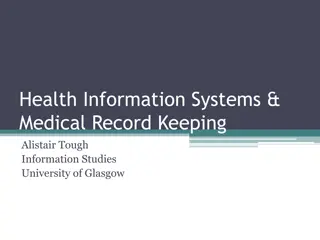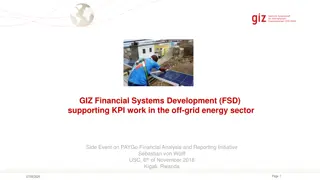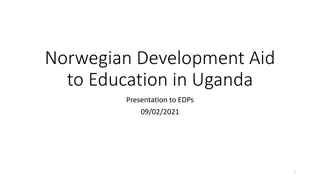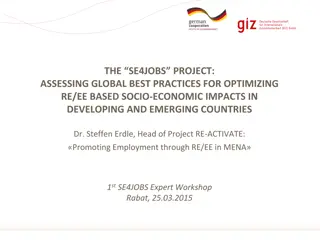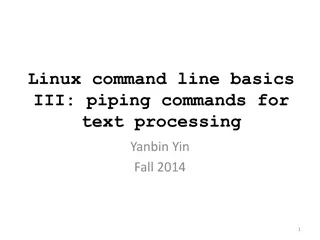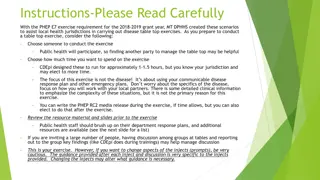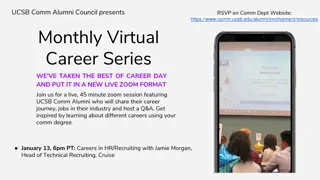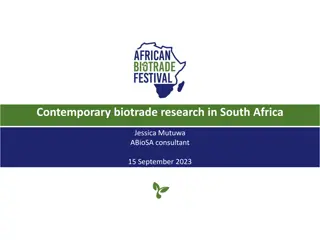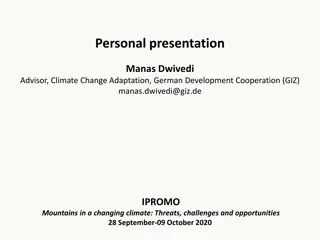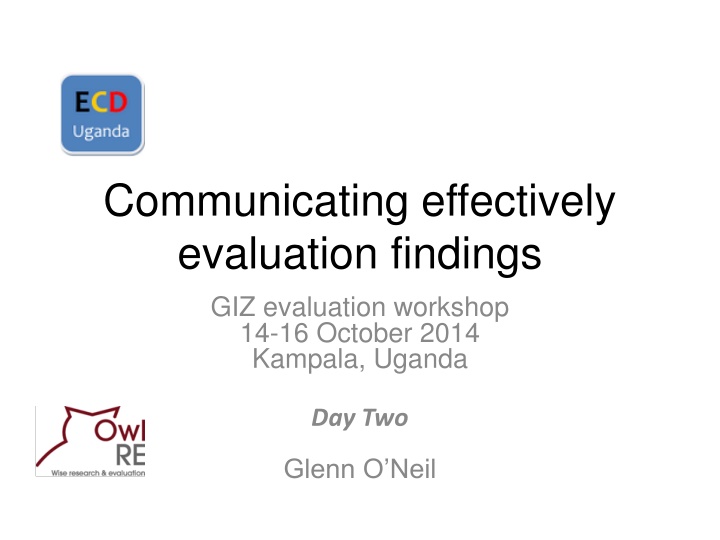
Effective Communication Strategies for Evaluation Findings
Discover key insights from the GIZ evaluation workshop in Kampala, Uganda, focusing on the importance of effectively communicating evaluation findings. Explore the challenges faced by evaluators and commissioners in message utilization, and learn about crafting impactful messaging strategies to convey evaluation outcomes concisely and effectively.
Uploaded on | 0 Views
Download Presentation

Please find below an Image/Link to download the presentation.
The content on the website is provided AS IS for your information and personal use only. It may not be sold, licensed, or shared on other websites without obtaining consent from the author. If you encounter any issues during the download, it is possible that the publisher has removed the file from their server.
You are allowed to download the files provided on this website for personal or commercial use, subject to the condition that they are used lawfully. All files are the property of their respective owners.
The content on the website is provided AS IS for your information and personal use only. It may not be sold, licensed, or shared on other websites without obtaining consent from the author.
E N D
Presentation Transcript
Communicating effectively evaluation findings GIZ evaluation workshop 14-16 October 2014 Kampala, Uganda Day Two Glenn O Neil
Workshop schedule Day 2: Promotion, messages, tools and presentation
Recap of day 1 What do you recall? What stands out for you?
Messages Commissioners of evaluations complain that the messages from evaluations are not useful, while evaluators complain that the messages are not used. Professor Lee Cronbach
Messages Normally in communication we would consider messaging in the initial communication plan But in evaluation we often have to wait until the initial finding emerge to know what we want to focus on when communicating findings
Messages But what to communicate from the often significant body of findings, conclusions and recommendations? It helps to have a messaging strategy: What is the most significant message coming out of the evaluation? What are the secondary messages (maximum four) coming out of the evaluation? What is the supporting information for these messages?
Messaging strategy - example Key message The most significant achievement of Oxfam s GROW campaign was securing policy changes on food and land from governments and corporations. Secondary Message 1 Oxfam was able to influence global land policy with the World Bank and to a lesser extent with governments. Secondary Message 2 The biggest challenge for Oxfam has been to engage with 50 million people with only 10% of this target reached. Secondary Message 3 Oxfam needs to consider where it has successfully built support and coalitions and merge this into a global movement on food. Supportive information Public commitment secured from World Bank; policy changes seen in 20 countries. Supportive information 5 million people reached mainly through social media actions on specific issues. Supportive information Findings show that Oxfam still has yet to harness and coordinate the support built through different initiatives.
Messages Messaging means making choices what are the most important points to get across? Evaluation, like many other technical fields, is rich in details but needs to be condensed for broader consumption You might need to think about messages per stakeholder/audience Messages are not designed to be distributed to audience they are your template for communicating
Exercise Read the evaluation findings provided to you Create a messaging strategy Report back to the plenary
After the evaluation Communicating findings can have different objectives but mostly: Disseminating findings: it reaches the right people Create awareness: people know what was achieved and challenges faced Encourage use: that people learn from the evaluation and it leads to improvements in programmes
Communicating findings 1. 2. Point point Point 3.
After the evaluation The communication plan should be reviewed considering the findings you now have Review the following: How widely do you want to disseminate the evaluation findings? What level of dialogue do you want to have on the findings? Have you foreseen the necessary communication tools required? Is your report user-friendly ?
Implementing the activities Timing is critical to success Important to determine who will do what and when Need time and budget to promote Activities must be planned to interact with each other in order to maximize impact, e.g. report is released and planned with stakeholder workshop A lot of activities will be for internal learning
Promotional tactics Look for opportunities to promote findings internally and externally (if appropriate) Consider key project/programme milestones where findings can be linked to Make sure your report gets visibility to all key persons Consider that you will have a six months window in which to promote your findings
Exercise Read the case study update Review your communication plan Report back to the plenary
7. Communicating good and bad results
Plenary exercise What tactics can be adopted to communicate negative findings?
Communicating negative findings People naturally like to communicate good news and downplay the bad Evaluation has to communicate the full picture and there is no easy solution However, some approaches or tactics are recommended .
Communicating negative findings 1. Involve stakeholders and project/programme staff throughout the evaluation 2. Keep stakeholders perspectives in mind 3. Communicate early with project/programme staff on negative findings 4. Present positive findings first 5. Use the voice of the beneficiaries 6. Place the emphasis on the future 7. Be careful in the use of negative language
8. Beyond the evaluation report other tools
1 page snapshot Visually attractive Messages summarised succinctly Accessible to many audiences Doesn tprovide full picture Not always suitable for complex evaluations Challenge to get agreement internally on what to include source: http://myvisualvoice.com/projects/visual-executive-summary
Infographic Visually attractive Understood rapidly Potential to reach many audiences Biased towards quantitative data May group unrelated data Challenge to get agreement internally on what to include source: http://www.depauluk.org/newsandresources/new- evaluation-shows-nightstop-emergency-housing-services-prevent- youth-homelessness-and-improve-health-and-wellbeing/
Video report Can tell a compelling story Can reach diverse audiences Visuals facilitate understanding Requires preparation during the evaluation (i.e. interviews) Requires video editing and animation skills (budget also) Source : http://www.youtube.com/watch?v=WJteTOYB2eI
Photostory Can tell a compelling story Beneficiaries voices strong Accessible for audiences Not suitable for all evaluations Cannot substitute more in-depth reports Source: http://insightshare.org/sites/default/files/LEAP%20Photostory_co mpressed_0.pdf
Interactive web page Visually attractive/interactive Creative way of displaying data Bias towards quantitative data Not suitable for all types of evaluation Can only display limited results Source: http://www.thegef.org/gef/RBM
Blog News approach facilitates interest Can relay voice of beneficiaries Potential to reach diverse audiences Only provides snapshot on evaluation Usually does not provoke substantial interaction (i.e. comments) Post may need vetoing which could delay publication Source: http://www.jointstandards.org/news/snapshotfromthejsiconsultat ioncairoegypt
Webinar Interactive format that promotes learning Can reach diverse audiences globally Can facilitate instant feedback Limited to less than 100 persons Requires reasonable internet connection More successful as presentation tool rather than for a discussion Source: http://www.seachangecop.org/webinars
Social media Can solicit feedback Excellent distribution channel Reaches diverse audiences Organisation must be ready to interact Feedback is public and can be negative Social media needs constant feeding to build audiences
Exercise Review your communication plan Consider which tools to use in addition Report back to the plenary
9. Communicating verbally your evaluation findings
Communicating verbally Most of you will have to present evaluation findings at one time or another Evaluation findings are challenging to present due to their complexity and jargon heavy language There are some recommended approaches for presenting findings...and recall best practices for presentations
Presentations and their impact A lot of what is recalled is how you present not what you say Most publics have a concentration span of 20 minutes maximum The most convincing presentations use a combination of personal experience ( I was there.. ) and logic-based evidence (e.g. satisfaction is rated low we need to improve ) Who is giving the presentation and the authority they have also plays an important role
Presentations recall rates Verbal only 70% 10% Visual only 72% 20% Verbal and Visual 85% 65% After 3 hours After 3 days
Best practices - presentations Therefore . Establish your credibility as a presenter Be aware of how you are presenting (body language) Adapt your presentation to your audience Keep your presentation brief Use visuals to explain your points If using PowerPoint each slide takes at least 2 minutes so no 50 slide presentations! Focus on 3-5 points to emphasize and repeat them in your conclusion
Best practices - presentations Six signals to send to your audience . 1. I will not waste your time 2. I know who you are 3. I am well organised 4. I know my subject 5. Here is my most important point 6. I am finished
Best practices - presentations Tell them what you are going to tell them Tell them Tell them what you ve told them Who are you? Why are you there? What will they learn? What is interesting for them? What are the 3-5 main points? Use of illustrations, examples, graphs, anecdotes, etc. Summarise: Repeat the 3-5 main points Attention span Start . Body ......... .Conclusion
Best practices evaluation presentations Be selective about what you present you can t present every single finding! Audiences tend to be interested in conclusions and recommendations more so than findings Use examples, quotes, survey graphs, anecdotes to illustrate your presentation Recall best practices focus on 3-5 points you want to emphasise and repeat them!
Q&A evaluation presentations The discussion after the presentation can be as informative as the presentation Often if people don t agree with your findings they will question your methodology - so be prepared to defend it! Be transparent about the limitations of your evaluation If someone is being argumentative suggest that you discuss it individually after the Q&A If you don t know a response to a question then say so and advise that you will look into it and get back to them with a response
Exercise Review the messaging strategy of your group Prepare an individual 5 minute summary presentation Be prepared to present!

